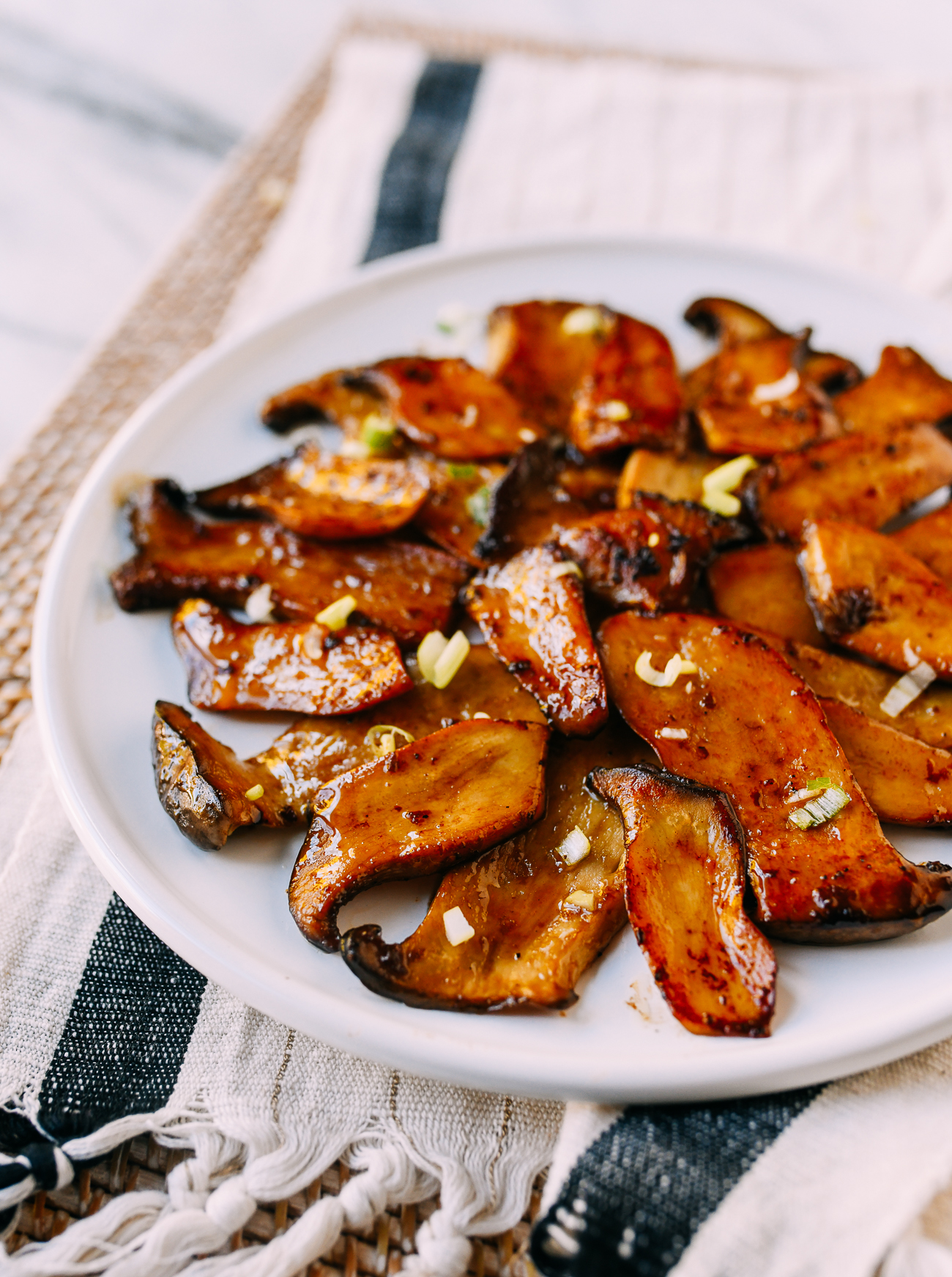Let’s talk about how to velvet beef! We have a lot of beef recipes in our archives here at The Woks of Life. We always give important details in all of our recipes, but I wanted to write a post focused on preparing beef properly for Chinese cooking.
Through the process of velveting, meats retain their moisture and take on a soft and velvety texture that is a signature quality of Chinese cuisine.
In this post, we’ll answer all your questions by including the step-by-step process, a video showing you how to velvet your beef for stir-fry, soups, and other recipes, recommendations for our favorite cuts, and how to properly slice beef for the wok—just like the Chinese restaurants do it.
What is Velveting?
While there weren’t many resources on the Chinese technique of velveting when we first started The Woks of Life in 2013, we’ve been blogging for over a decade, and the cat’s out of the bag! That said, you might find conflicting information out there, leading only to confusion and more questions.
Some sources suggest using egg white. Some equate velveting with marinating, while others describe it as a cooking technique. So what is it?
Velveting is a Chinese technique that involves marinating proteins with a mixture of oil and cornstarch to give proteins a “velvety” texture after cooking in hot oil (oil velveting) or boiling water (water velveting). The cornstarch and oil form a barrier that locks in juices and protects the meat from the hot cooking medium, and additional seasonings in the marinade add flavor.
Beyond the oil and cornstarch, you can add moisture to the meat itself by adding water and mixing until the meat has absorbed it. You can also add liquid seasonings, like soy sauce, oyster sauce, sesame oil, and Shaoxing wine.
If you’ve ever wondered why the stir-fried meats you get a Chinese restaurants are so juicy, tender, and silky, while your attempts at home turn out a bit dry and flavorless, this is the secret.
Chinese velveting techniques vary, depending upon the cut and type of meat or seafood used for the dish. See also our posts on how to velvet chicken, pork, and shrimp.
For beef in particular, baking soda acts as an optional additional tenderizer. We have two methods for this—a shortcut method, and a water rinsing method, both of which we will describe in detail.
When it comes to using baking soda as a tenderizer, it’s important not to go overboard. Using too much or allowing the beef to sit too long will result in a bitter, soapy taste and a rubbery texture.
What Cut of Beef is Best for Stir-fry?
Flank steak is by far the most popular cut of meat for stir-fry dishes. It also happens to be the cut we most often recommend in our stir-fry recipes.
Flank steak is flavorful, relatively reasonably priced (though it is becoming more expensive), and readily available. With its intense beefy flavor, all you need to do is slice and marinate it properly for a great stir-fry.
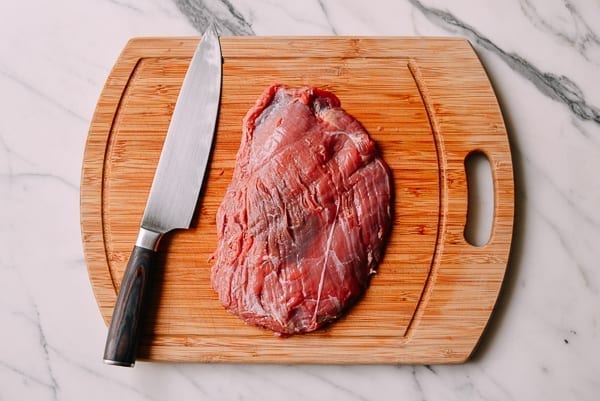
Boneless beef chuck steak is a more economical choice for beef stir-fries. We like using beef chuck steak for stewing and braising because of the extra fat that comes with this cut of meat, but it can also work nicely for stir-fries, as long as you slice it properly and tenderize it (we’ll get to that later in this article).
Chuck steak is also more economical than flank steak. You can buy a large piece, slice it, divide it into portions for several stir-fries, and freeze it!
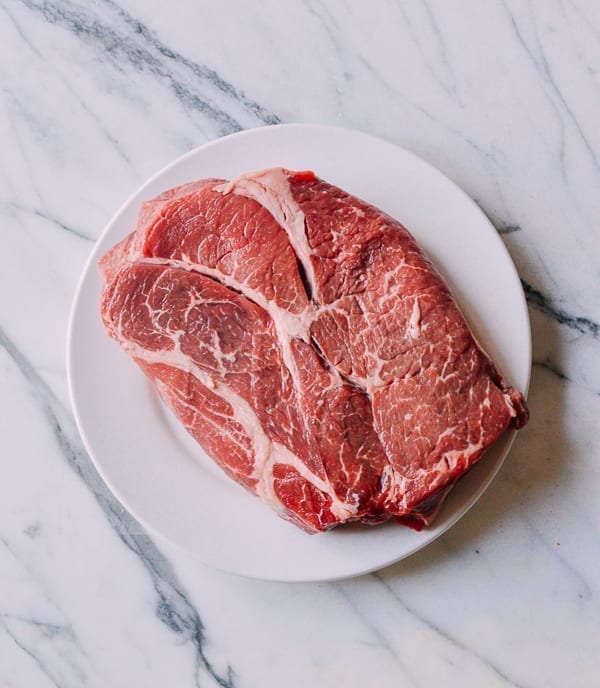
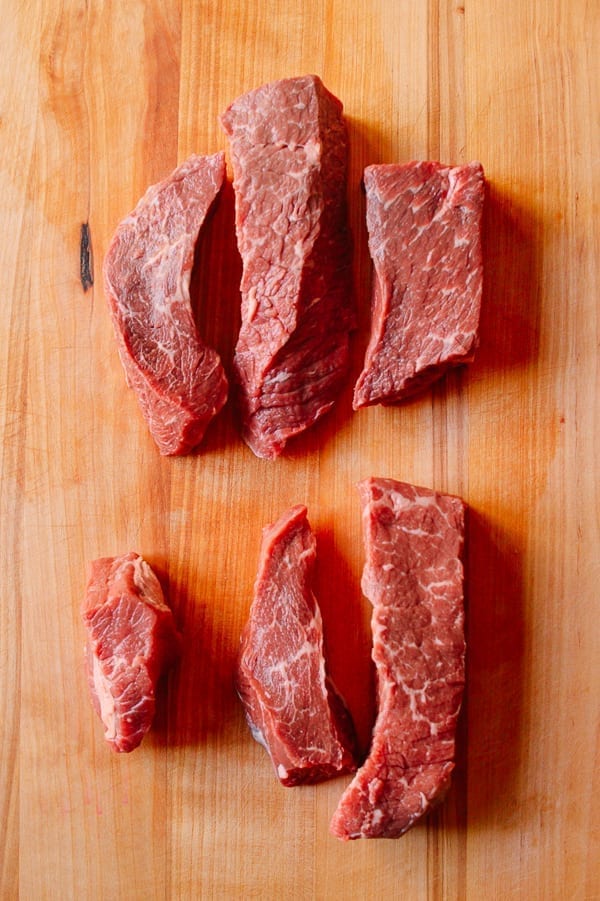
Watch: Bill tests two methods for velveting beef!
How to Cut Beef For Stir-fry
If using flank steak, trim off any white muscle membranes, and cut your flank steak along the grain lengthwise into 2 to 2 1/2 inch strips.
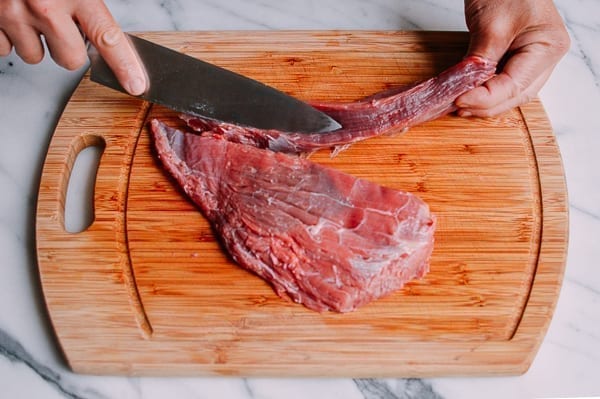
It’s easy to identify the long grains of muscle fiber in flank steak. When slicing the flank steak into small pieces, slice against the grain (perpendicular to the long lines of muscle).
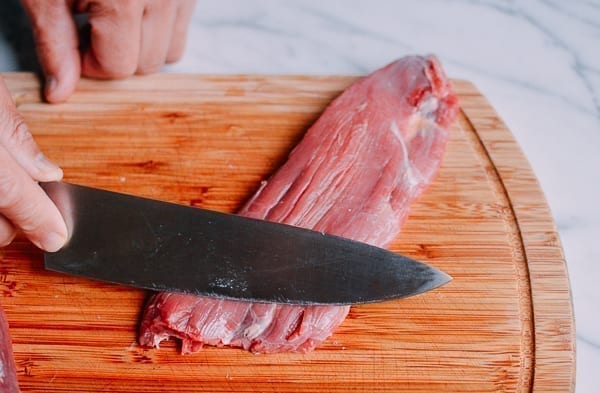
Make each slice 1/4″ thick––each piece will be tender and bite-sized. Keeping the knife at about a 45° angle also makes the slices larger/wider.
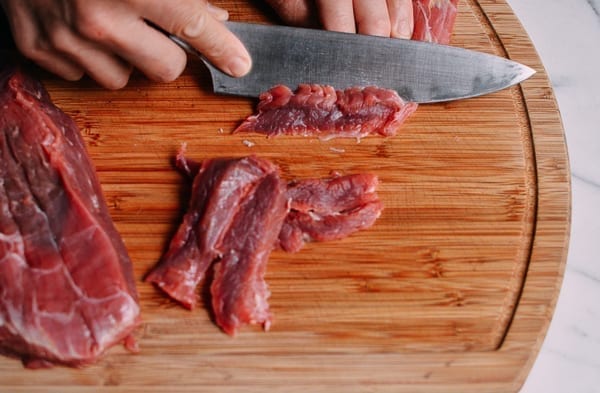
Now your beef is ready for marinating!
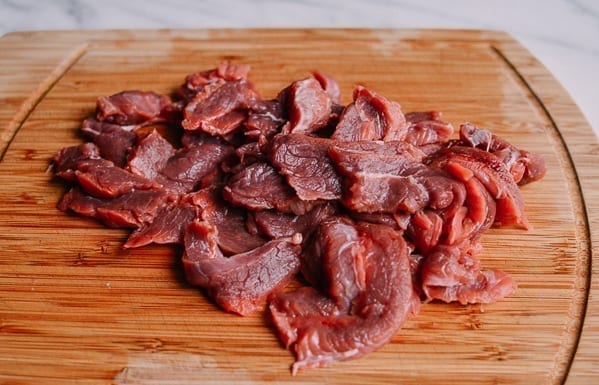
If using boneless beef chuck, check out our instructions for how to slice it below. If not, skip down to the next section.
Cutting Boneless Beef Chuck for Stir-fry
A little more trimming and care is required to prepare beef chuck steak for stir-fry. Cut along the fat lines and remove the thick membrane to get some neat chunks of beef for slicing. Use a good chef’s knife, and as always, be careful when working with sharp knives!
Cutting meat against the grain is very important to yield nice tender pieces in your stir-fry dishes.
Again, the “grain” refers to the long strands of muscle running through the beef parallel to each other. Cutting against the grain means cutting across those strands, making the long strands of muscle shorter to create small, tender pieces.
It’s much harder to identify how the grain runs in beef chuck than for flank steak. In this photo, you can see the pattern of meat and fat where the grain runs vertically.
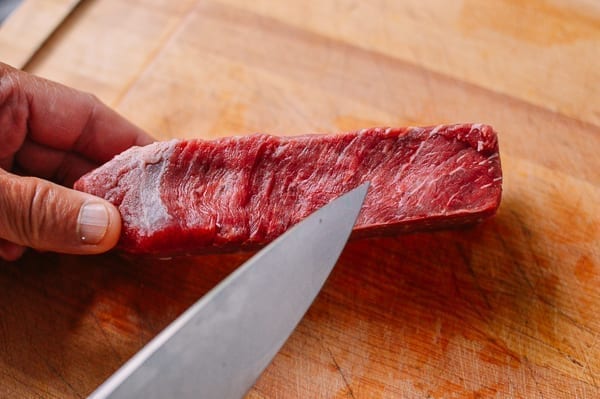
Since we have to cut cross-wise to the grain, we need to cut this long strip into 2-inch wide chunks first.
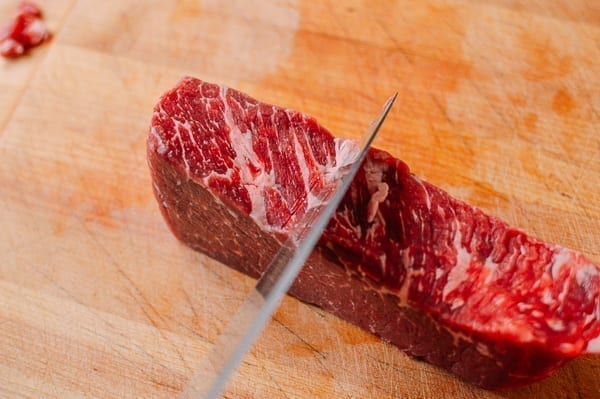
And then position each piece so you’re cutting the long fibers short.
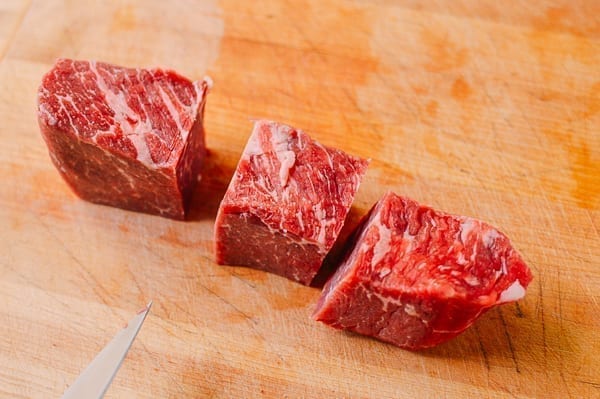
See how the knife is positioned where it will cut the meat against the grain?

Now cut your beef into 1/8 to 1/4 inch (3-6mm) slices:
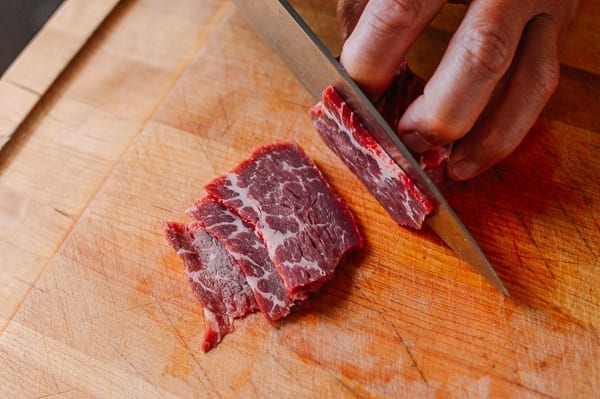
You can see the grain and the slice a bit clearer in this photo, but you can imagine that the soft beef can be difficult to handle and slice.
A chef’s secret to slicing beef quickly is to freeze the meat partially for 30 to 60 minutes until firm.
This makes slicing much easier and faster, as the firm beef does not slide under your knife and around the cutting board. Partially frozen meat also allows you to be more precise in cutting to your desired thickness.
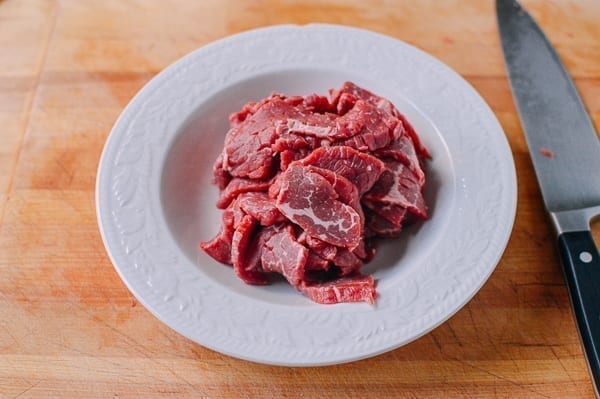
How to Cut Beef for Lo Mein & Other Noodle Dishes
If using beef for noodle dishes or dishes like Beef and Pepper Stir Fry, an extra step to slice beef into thin strips (julienne) is required.
In Chinese stir-fry cooking, the way ingredients are cut should be consistent with each other. Rectangular slices of beef are used for stir-fries with larger ingredients like beef and broccoli or beef and tofu. Long strands of noodles like you have in Beef Lo Mein require beef to be cut into similar long thin strips.
Beef fried rice requires small chunks of meat to go with the small grains of rice. Make sense?


How Chinese Restaurants Tenderize Beef
It’s time to share some Chinese restaurant secrets on how to tenderize beef. Depending on the cut of beef, you may want to tenderize it as a first step before completing the marinating and velveting process.
The first step is to add a good amount of baking soda to the beef––about 1 teaspoon per pound (450g).
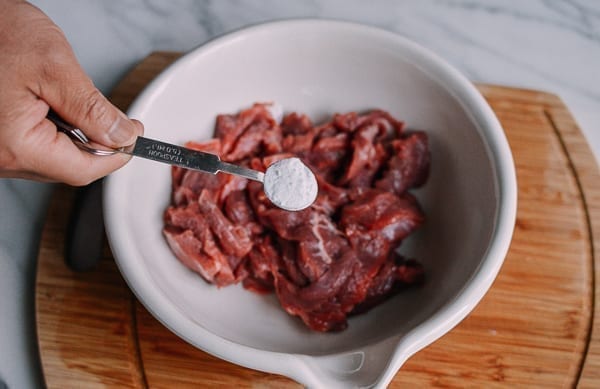
Next, add 1/4 cup (60 ml) water (per pound of beef), and massage the beef so the baking soda and water is uniformly distributed. Set aside for 1-2 hours. This step tenderizes (baking soda) and hydrates (water) the beef.
Next, the beef must be rinsed thoroughly under running water to rid it of any excess baking soda, or you will taste it in the dish.
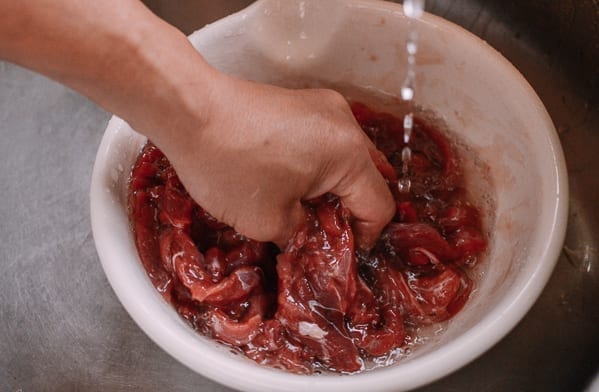
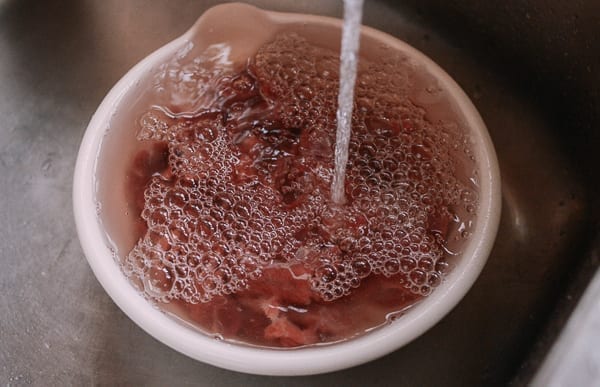
Use your hands to stir up the beef during the rinsing process.

Once the water runs clear, drain the beef thoroughly in a colander and transfer it to a bowl for the marinating process (details in next section).
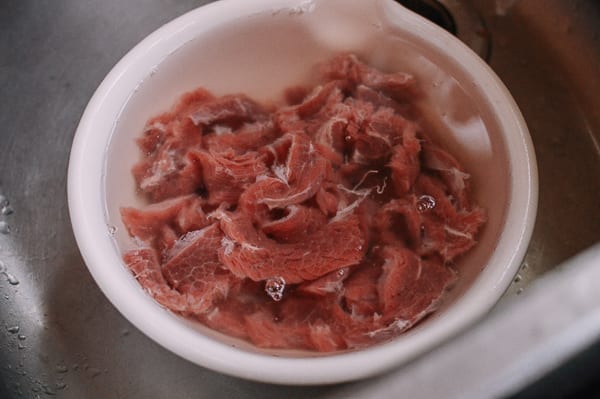
Shortcut to Tenderizing Beef at Home
If the process used by Chinese restaurants to tenderize beef described above sounds a bit like a hassle, you can still tenderize beef using a shortcut.
Baking soda is a powerful tenderizer, but if you add too much, it can add an off-taste to the beef. This is why you need to rinse it off.
The solution is to add a smaller amount of baking soda without rinsing it off. Adding 1/8 teaspoon to 1/4 teaspoon (depending on how tough the cut is) of baking soda and 2 to 3 tablespoons of water per pound of beef.
You can add it along with the rest of your marinade ingredients. Increase the marinating time for your beef by about 15 minutes (or let it sit overnight).
This method is simpler and yields a slightly less tender beef that will retain more of its flavor.
I will also say that adding water to the beef is a personal choice. I feel there are merits to having both moist hydrated beef or a drier beef for some stir-fry dishes.
Making the marinade
The marinade isn’t about soaking the beef in liquid or adding a bunch of aromatics and spices like you may be used to. It’s about giving the beef an extra juicy texture.
After the beef has been tenderized:
- Add oyster sauce and/or soy sauce to give your beef an extra flavor boost. Add about 2 teaspoons of each per pound of beef.
- Add cornstarch and oil to give the meat a velvety texture. Add about 2 teaspoons of each per pound of beef.
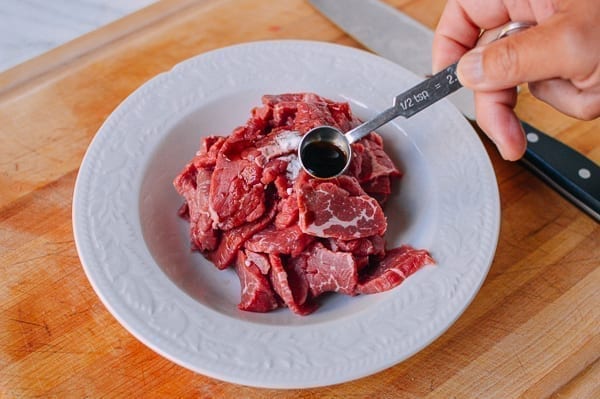
The cornstarch and oil gives the beef its velvety smooth texture, protecting the meat during cooking.
Adding Shaoxing wine (2 teaspoons per pound) also adds flavor. This is totally optional for those of you who would rather not consume alcohol.
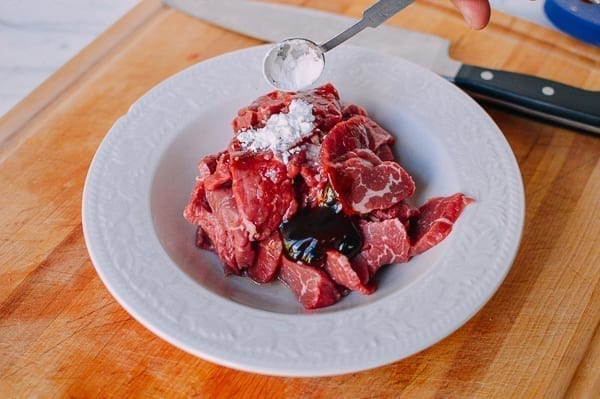
3. Mix everything together and set it aside to marinate for 15-30 minutes while you’re preparing your other ingredients.
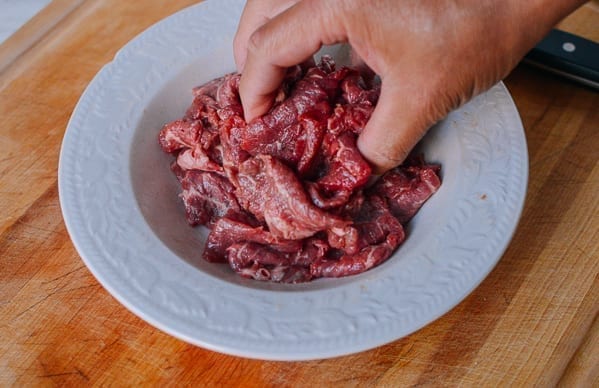
The Final Step in velveting: Pre-cooking
Velveting beef begins with the steps we have explained above. (Tenderizing the beef and then marinating it with seasonings, oil and cornstarch.)
The tenderizing step makes any cut of beef soft and moist, while marinating the beef gives it more umami flavor and that velvety coating you experience when eating at Chinese restaurants. Pictured below is the marinated beef before cooking.
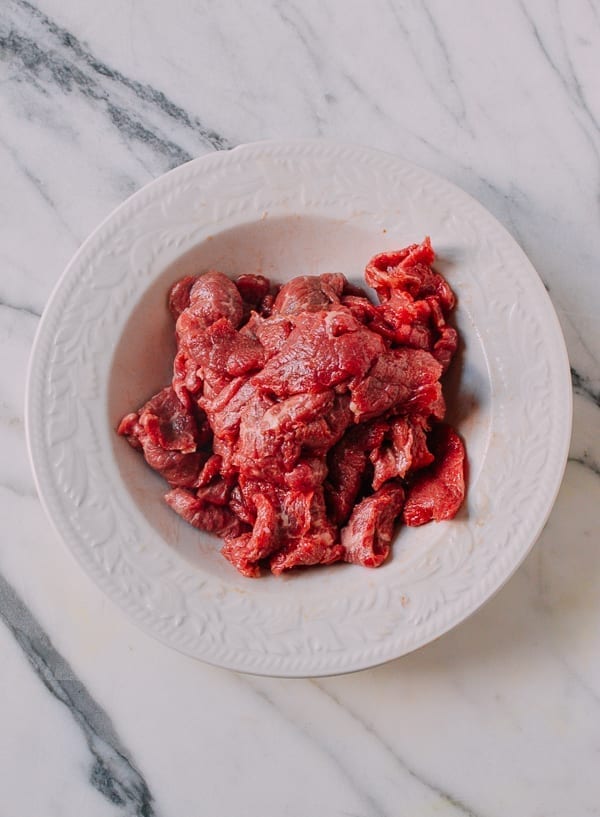
The last step of velveting is pre-cooking. The method depends upon the dish you are making and the outcome you’re looking for.
The traditional method for velveting beef is to pass the meat through hot oil (essentially deep frying). The Chinese term is zǒu yóu (走油) in Mandarin or “jau yau” in Cantonese.
In most cases, we prefer to sear the meat in a hot wok. Having a wok full of oil at home isn’t as practical. And actually, we think searing beef imparts more flavor than the jau yau deep-frying method.
Some recipes, including soups, will only require cooking the beef in water as the final step. See recipes like our West Lake Soup in our cookbook for an example!
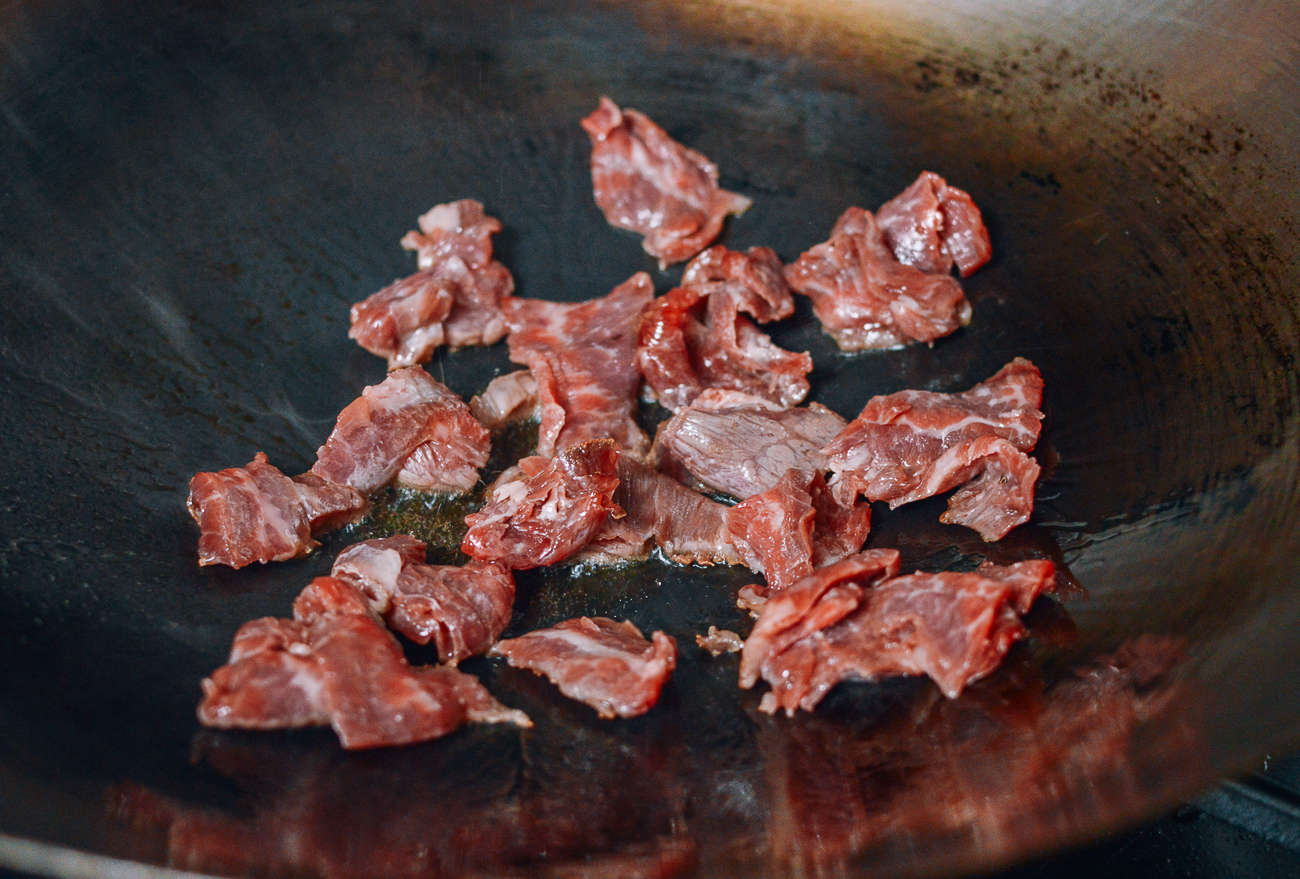
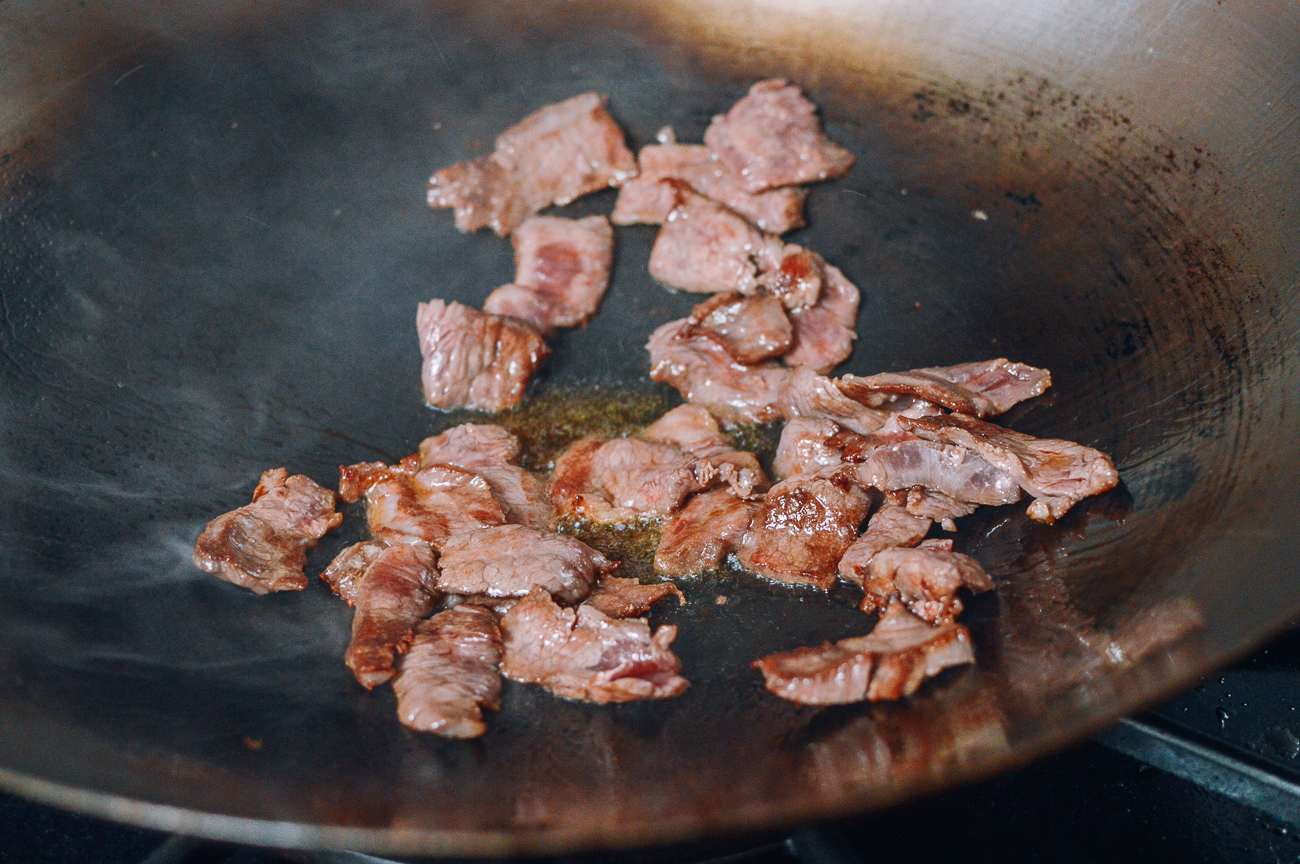
That’s it! Everything you need to know about how to velvet beef for stir-fry and other dishes. Let us know in the comments if you have any questions!
Looking for more authentic recipes? Subscribe to our email list and be sure to follow us on Pinterest, Facebook, Instagram, and Youtube!
Recipe
How to Velvet Beef for Stir-fry
Ingredients
- 1 pound beef flank steak or chuck steak (450g, sliced against the grain)
- 1 teaspoon baking soda
- water 1/4 cup (60 ml) per pound
- 2 teaspoons vegetable oil
- 2 teaspoons oyster sauce or soy sauce
- 2 teaspoons cornstarch
- 2 teaspoons Shaoxing Wine (Optional)
Instructions
- Add baking soda and water to the sliced beef and massage with hands until most of the liquid is absorbed. Let stand 1-2 hours.
- Rinse the beef thoroughly under running water until the water runs clear. Drain.
- Add oil, oyster sauce/soy sauce, Shaoxing wine (optional), and cornstarch to the beef. Set aside to marinate for 15-30 minutes, and then your beef is ready to use.












